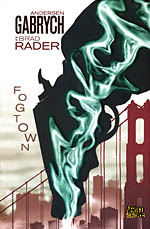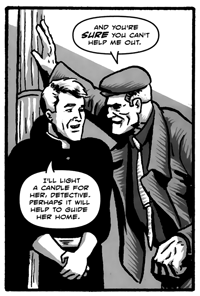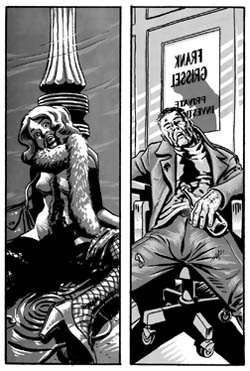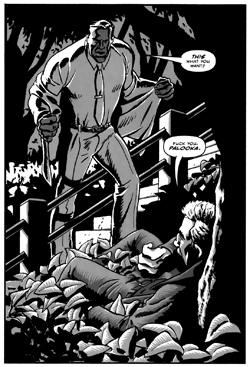 Written by Andersen Gabrych
Written by Andersen Gabrych
Art by Brad Rader
176 pages, black and white
Published by Vertigo Comics
After several initial disappointing releases from the Vertigo Crime line of books, I pinned a lot of hopes on Fogtown by Andersen Gabrych and Brad Rader. I’ve loved what little art of Rader’s I’ve seen in the past (most notably on an early Catwoman story written by Ed Brubaker), and his animation pedigree has shown him to be an expressive and inventive artist. And while I’d never read any of Gabrych’s stories for DC Comics, having two openly gay men working on a crime thriller in 1953 San Francisco certainly held a lot of potential. What I actually found with Fogtown, though, is a book where some parts of the greater whole fail, while others try and pick up the slack.
 Fogtown is a book where Gabrych tries to keep the reader on their toes, reminding us time and time again that not everything is as it seems. We get a quick reversal of this upon meeting Frank Grissel and Loretta Valentine; in their first page together, Frank squirms away from Loretta as she tries to clean off the bruises on his face, shouting, "God-bless it, Loretta! You’re my secretary, not my mother." No sooner do we get the relationship Gabrych is establishing here—Loretta cares for Frank but it’s strictly a business relationship for Frank—than he tears it down. It’s on the next page, three panels later, that Loretta states (after some silence), "You didn’t come home last night." Then again, the turnabout moment is almost a cliche in crime fiction, and Gabrych isn’t afraid of adding the cliche into the book. He admits as much early on, with a psychiatrist noting that, "it’s not every day you meet a true-blue cliche," in this case referring to Frank himself. It’s something that holds true throughout the book, and while the characters themselves note it time and time again ("Ah, Christ, lady, that old routine? Trust me? You don’t even know me.") it’s still hard to shake the feeling that the plot is slightly recycled, and serves only to service other aspects of the book.
Fogtown is a book where Gabrych tries to keep the reader on their toes, reminding us time and time again that not everything is as it seems. We get a quick reversal of this upon meeting Frank Grissel and Loretta Valentine; in their first page together, Frank squirms away from Loretta as she tries to clean off the bruises on his face, shouting, "God-bless it, Loretta! You’re my secretary, not my mother." No sooner do we get the relationship Gabrych is establishing here—Loretta cares for Frank but it’s strictly a business relationship for Frank—than he tears it down. It’s on the next page, three panels later, that Loretta states (after some silence), "You didn’t come home last night." Then again, the turnabout moment is almost a cliche in crime fiction, and Gabrych isn’t afraid of adding the cliche into the book. He admits as much early on, with a psychiatrist noting that, "it’s not every day you meet a true-blue cliche," in this case referring to Frank himself. It’s something that holds true throughout the book, and while the characters themselves note it time and time again ("Ah, Christ, lady, that old routine? Trust me? You don’t even know me.") it’s still hard to shake the feeling that the plot is slightly recycled, and serves only to service other aspects of the book.
 Gabrych’s script in Fogtown appears to be more interested in exploring the double life of a closeted gay man in 1950s San Francisco than the actual murder storyline. Frank’s sexuality is a plot point that is hard to miss even as the book plays coy with it on numerous occasions. From lines such as, "How many other secrets you got in that closet, Frank?" to "It looks like you have some gentleman callers," the innuendo drips freely and blatantly. It’s when Gabrych’s script gets a little more subtle that it becomes interesting, like Frank’s tentative flirting with the military men until they find out that he’s not one of them, for example, or Loretta’s "Kiss me Frank, just this once," after they have sex on top of his desk. Still, for every quiet moment there’s one that goes back to blatant; how else can you describe the large African-American sex god being given the name of Bone? It’s too bad because if you took out the innuendos and double-talk there’s a spark of a good idea here—it’s ultimately the best part of Fogtown—but it never quite goes far enough.
Gabrych’s script in Fogtown appears to be more interested in exploring the double life of a closeted gay man in 1950s San Francisco than the actual murder storyline. Frank’s sexuality is a plot point that is hard to miss even as the book plays coy with it on numerous occasions. From lines such as, "How many other secrets you got in that closet, Frank?" to "It looks like you have some gentleman callers," the innuendo drips freely and blatantly. It’s when Gabrych’s script gets a little more subtle that it becomes interesting, like Frank’s tentative flirting with the military men until they find out that he’s not one of them, for example, or Loretta’s "Kiss me Frank, just this once," after they have sex on top of his desk. Still, for every quiet moment there’s one that goes back to blatant; how else can you describe the large African-American sex god being given the name of Bone? It’s too bad because if you took out the innuendos and double-talk there’s a spark of a good idea here—it’s ultimately the best part of Fogtown—but it never quite goes far enough.
It’s Rader’s art in Fogtown that ultimately kept grabbing my interest even as the script failed. It’s a dramatic and expressive art style, a reminder to me that we get far too little of Rader’s work in comics. From an early page that echoes a murdered prostitute’s pose to that of a passed out Frank, I found myself impressed with how much he was able to pack into those two panels; a damaged body that is as unsexual as they come even while dressed up in a typical seductress outfit, and then Frank’s own battered body with a rough, raw sexuality that oozes off the page.
 It’s that sexual nature that permeates the entire book; there are few other books where the art has you unsure if a scuffle between two men is a prelude to a beating, or the start of a dangerous game of foreplay. Sex and violence work well together in Fogtown, and Rader’s successful pairing of the two are what will make people remember the book above all else. Even Rader isn’t afraid to dip into the cliche well at times, though; the interior of the Black Cat bar looks like it was populated solely by characters from Tom of Finland’s iconic drawings, for instance. Still, with such great art from start to finish (aided with gray tones by Rivkah), this is a sharp looking comic.
It’s that sexual nature that permeates the entire book; there are few other books where the art has you unsure if a scuffle between two men is a prelude to a beating, or the start of a dangerous game of foreplay. Sex and violence work well together in Fogtown, and Rader’s successful pairing of the two are what will make people remember the book above all else. Even Rader isn’t afraid to dip into the cliche well at times, though; the interior of the Black Cat bar looks like it was populated solely by characters from Tom of Finland’s iconic drawings, for instance. Still, with such great art from start to finish (aided with gray tones by Rivkah), this is a sharp looking comic.
"I’m a shit detective," notes Frank toward the end of Fogtown, and that’s unfortunately another correct assessment that doesn’t do a good enough job of hiding the problems with this book. This is a book where secondary characters perform most of the connecting of the dots, and the book ultimately comes to a climax around Frank rather than because of anything he did proactively. I’d hoped for much more out of Gabrych’s script, even as I reveled in Rader’s art.
This is a book that could have been so much better, but in the end I can’t help but feel that it succeeds on some level despite the script rather than because of it. Buy this because you’re a fan of Rader’s art, or for steamy (but PG-13 at most) homoerotic comic art that manages to go beyond almost anything you’ll see in a DC or Marvel book. But just know that in the end, the string of cliches that they’re drawing just isn’t up to the same level.
Purchase Links: Amazon.com | Powell’s Books
